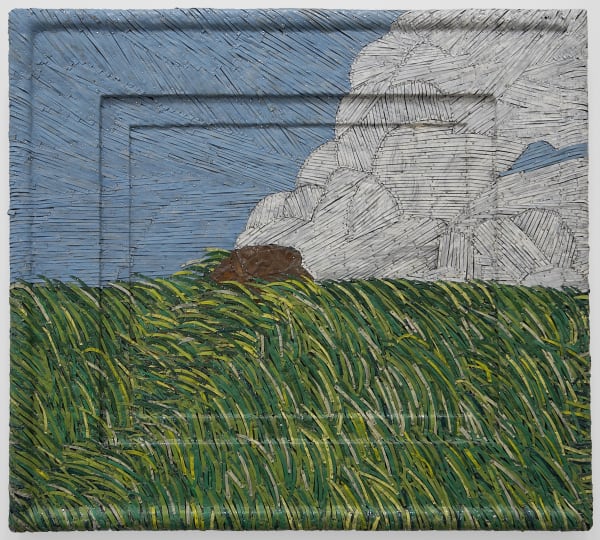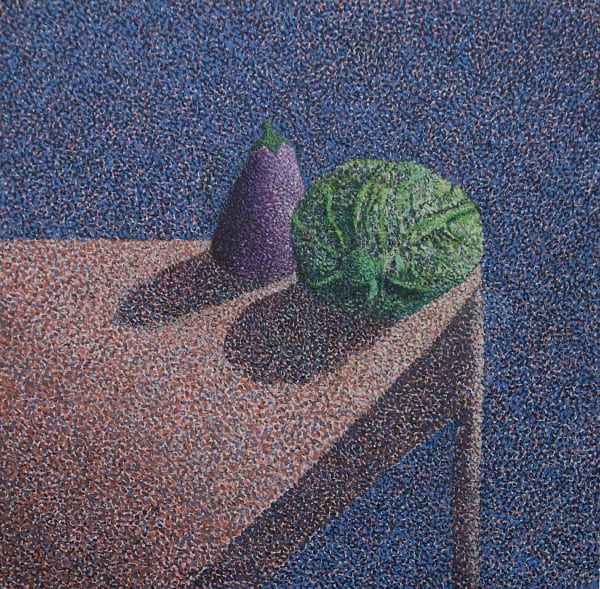Susan Inglett Gallery will be exhibiting Robert Kobayashi at the upcoming ADAA Art Show. Included are both the artist’s signature mixed media metal constructions as well as a selection of the pointillist oil paintings that preceded. The staccato rhythm of these early canvases inspired the bricolage metalwork that came to define his career.
Leaving Honolulu to join the War effort, Kobayashi came to NYC at the close of World War II to continue his studies at the Brooklyn Museum School. He exhibited alongside the AbEx artists in shows at Brata and Camino Galleries and with art dealer Sam Koontz. Successful but not satisfied, Kobayashi left abstraction behind to experiment and explore. In 1979, he purchased a building on Elizabeth Street in Little Italy that once housed the local butcher shop. The space assumed various guises, ultimately settling into its role as a gallery operating under the moniker of Moe’s Meat Market. Here, Kobayashi continued to develop the neo-pointillist approach which ultimately led to the mixed media metal works for which he became known. Dubbed clouage, taken from the French verb “to nail,” Kobayashi cobbled together 2- and 3-D works from discarded local ceiling tin as well as beer and Cafe Bustelo cans. The hammered surface of the tin tiles and raised nails mimicked the pointillism of the paintings, bridging the artist’s approach to these two media.
Whether employing paint or tin, Kobayashi’s working method displays a distinct materiality. Considering the bust, Fumiko in the Wind, the nail heads and hammered holes atomize the surface like the multi-colored dots which form shade and dimension in the painting, String Beans. Sheets of metal, repurposed and renewed with the artist’s touch, now appear light and fluid— Kobayashi conveys the curvature of the figure in Black Nude or the roundness of the apple in Glass Cup with slender strips of metal applied like strokes of paint. The embossed ceiling tiles add texture, serving at times as “the thing-in-itself.” The process of making suggests a meditation and is reinforced by the artist’s chosen subject matter: the grassy field of Rock on Ernsthausen’s Farm captured again in a pointillist view through the casement of Vermont Window or the stoicism of a solitary vase of Still LIfe in a Corner. The quiet immediacy of these subjects underscores Kobayashi's patient attention towards his chosen materials.
Robert Kobayashi grew up in Honolulu, HI, attending the Honolulu Academy of Art before moving to New York to enroll in the Brooklyn Museum School of Art. He began work at the Museum of Modern Art, NYC as the caretaker for their Japanese Exhibition House in 1954, a position that fostered opportunities to grow as an artist during a defining moment in the New York art world. Following an exploration of abstract expressionism, Kobayashi sought to differentiate himself from his abstract peers by pursuing materials and techniques that more closely aligned with his interests. In 1988— ten years after opening Moe’s Meat Market— the artist had his first major solo exhibition, Tattooed Angel: Paintings and Sculpture by Robert Kobayashi, at the Nassau County Museum of Fine Art. Kobayashi continued to exhibit his work at Moe’s Meat Market, using the space to exclusively display his art later in his career. In the last years of his life, he moved back to his native Honolulu, continuing to make work in his clouage technique until his death. Kobayashi was the subject of a 2020 solo exhibition at the Gallery, Moe’s Meat Market, which was reviewed in The New York Times, The New Yorker, and New York Magazine, among additional publications. His work can be found in the permanent collections of the Museum of Modern Art, NYC; the Brooklyn Museum; and the Honolulu Museum of Art, among others.
Thursday, November 4, 12–8 PM
Friday, November 5, 12–8 PM
Saturday, November 6, 12–7 PM
Sunday, November 7, 12–5 PM









